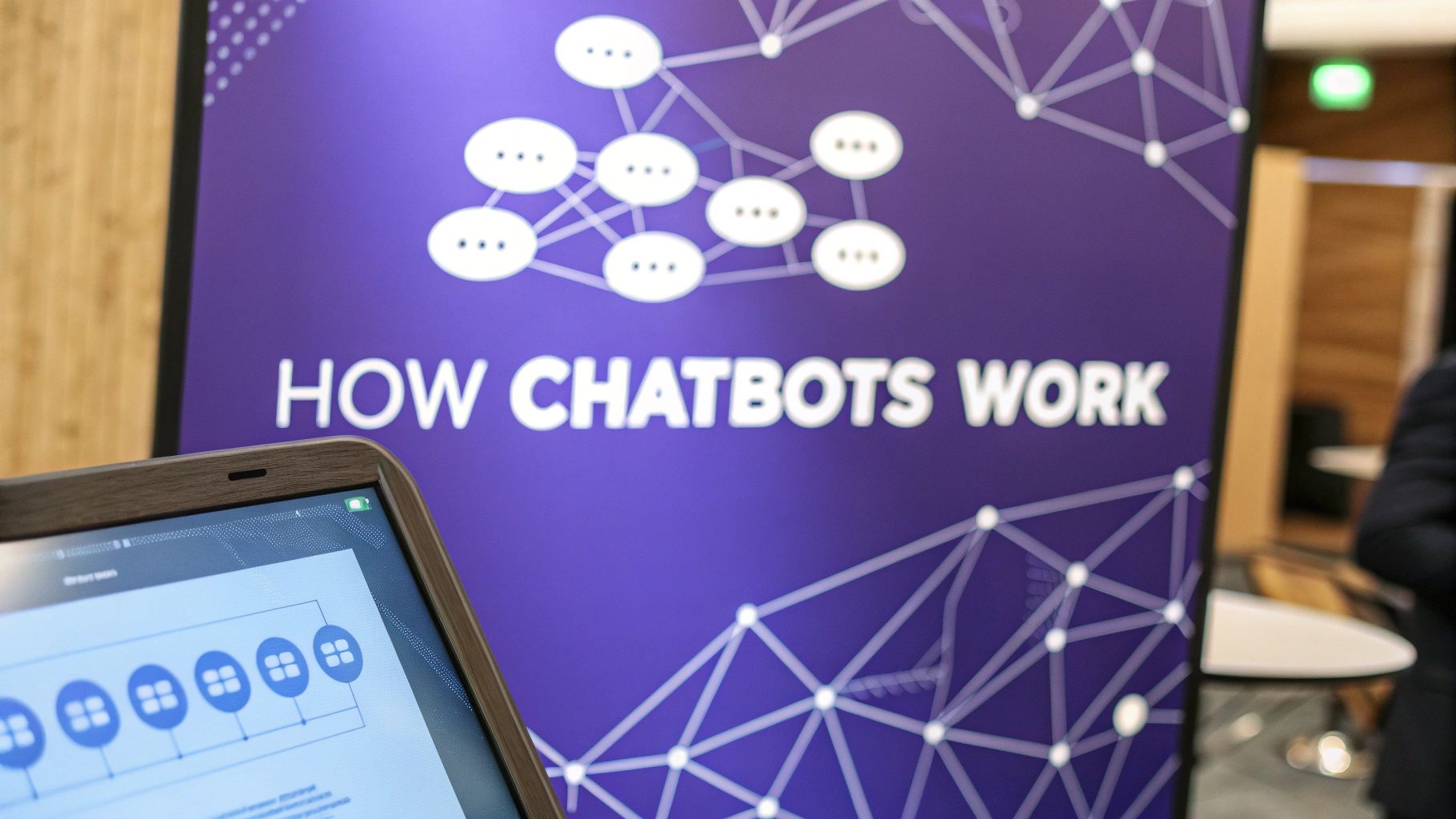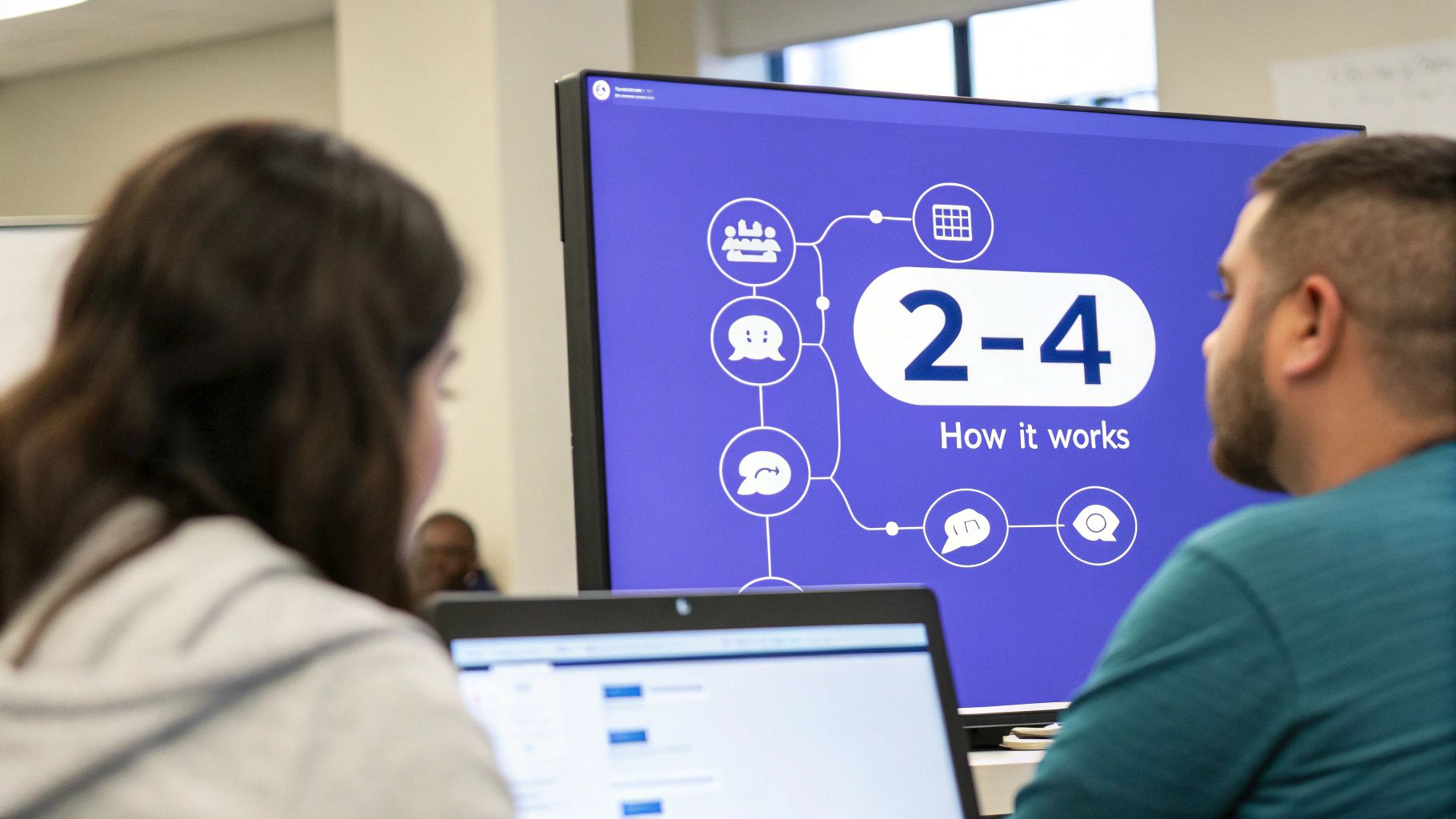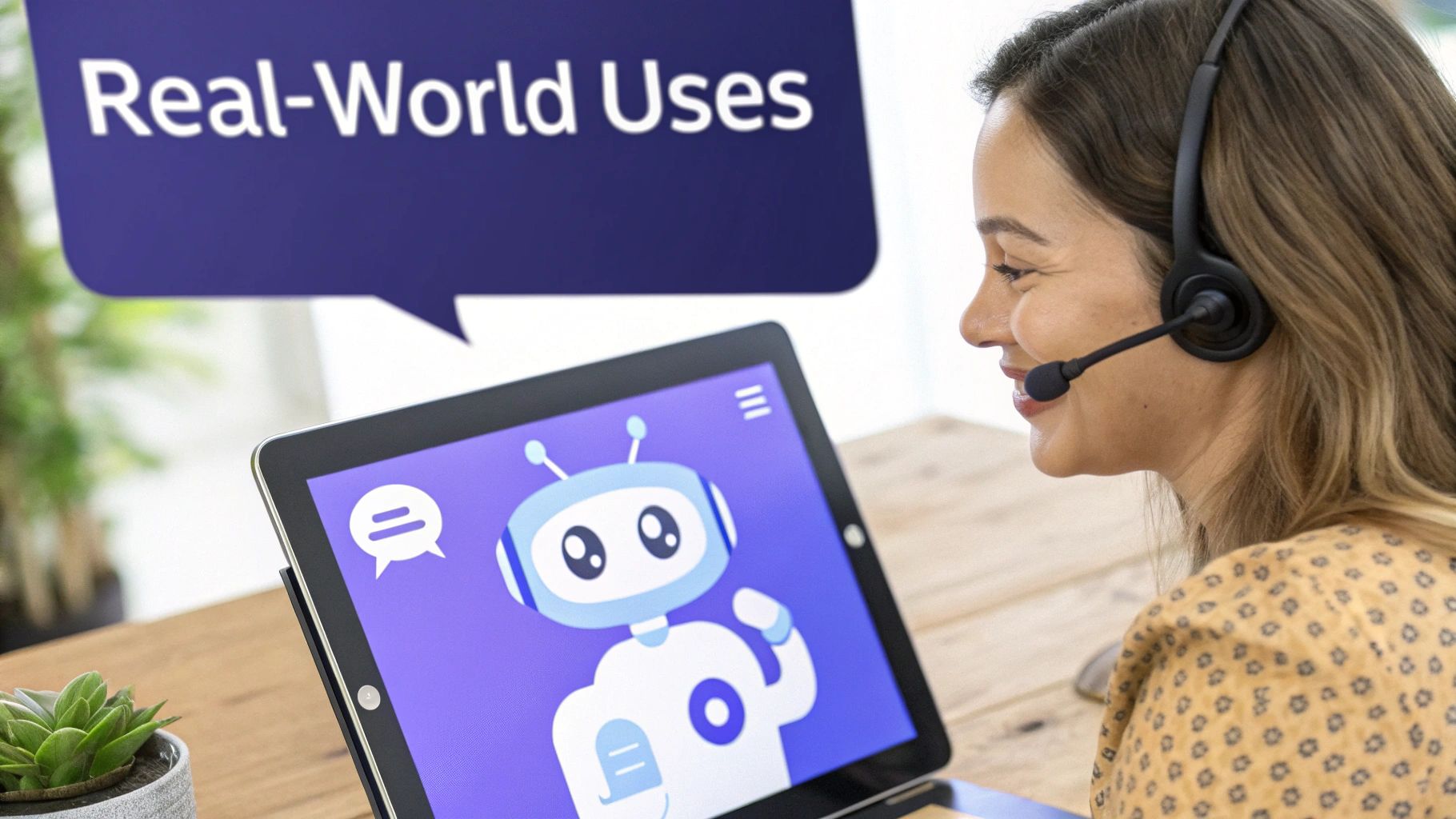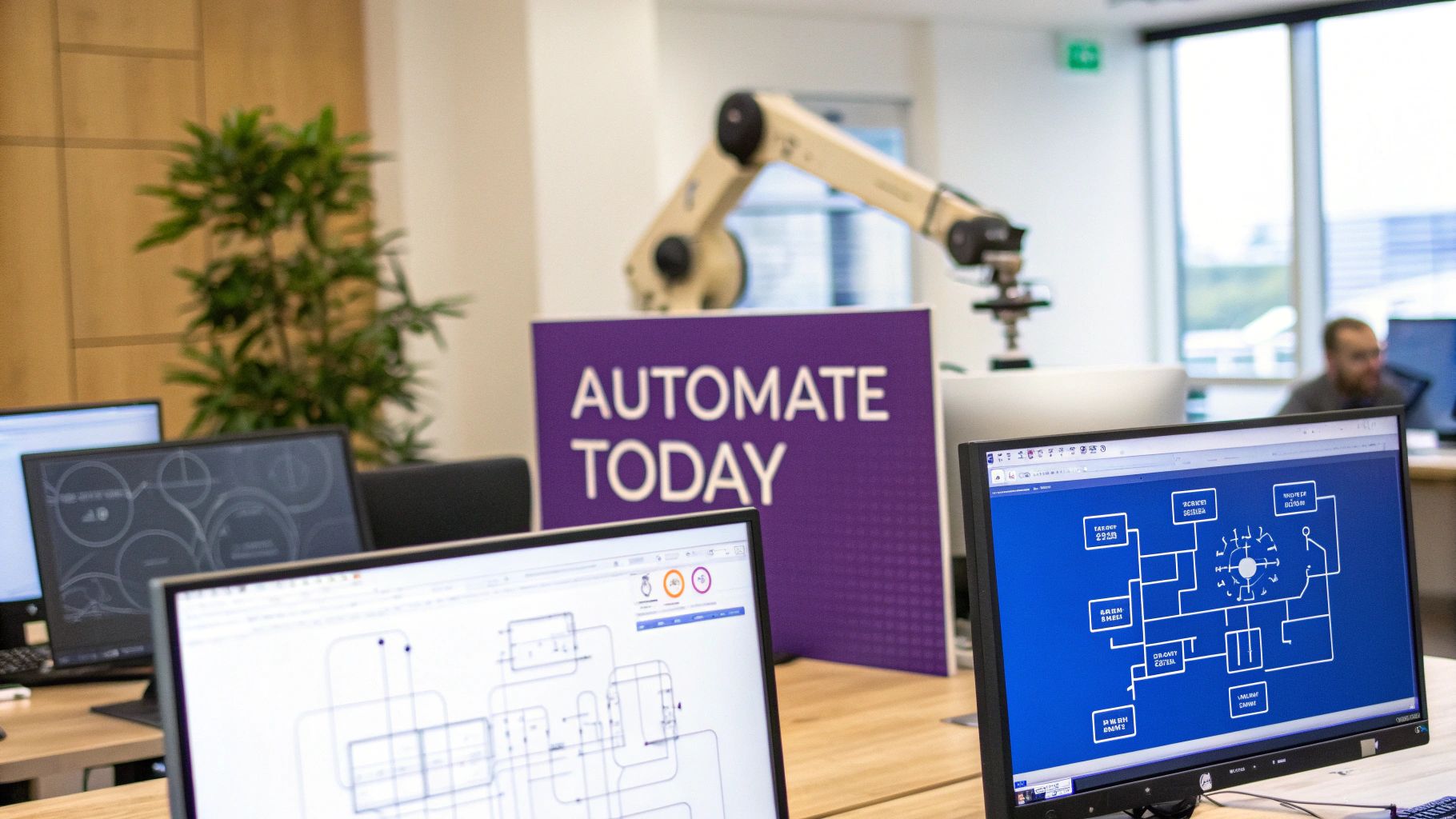How Do Chatbots Work? Simple Explanation
Wondering how do chatbots work? Discover a clear, concise guide to their technology and how they process conversations effectively.

Ever asked a website for help and gotten a reply in seconds? Chances are, you were talking to a chatbot.
At its simplest, a chatbot is just a computer program built to have a conversation with you, either through text or voice. Think of them in two main ways: simple rule-based bots that follow a strict script, like a flowchart, and advanced AI bots that actually learn from what you’re saying.
How Chatbots Understand and Respond to You
When you chat with a bot, you’re tapping into a piece of tech that now plays a big role in how we interact online. These programs do more than just send automatic replies; they help businesses handle everything from customer service to sales. The aim stays the same: give people quick answers without making them wait for a human.
Businesses are all-in on automating support and making workflows run smoother. The global chatbot market is projected to hit $46.64 billion by 2029—up from where it stood just a few years ago. You can see more on this trend in the latest chatbot statistics from Exploding Topics.
The Two Main Types of Chatbots
To see how chatbots work in practice, it helps to start with the two main categories they fall into. Each type operates differently and is built for a different set of tasks. One is straightforward and predictable. The other adapts and can handle a few curveballs.
Rule-Based Chatbots: These are the simplest. They run on a set of pre-defined rules and scripts, a lot like an interactive FAQ. Ask a question it knows and it gives you a pre-written answer. Go off-script and it doesn’t know what to do next.
AI-Powered Chatbots: These use artificial intelligence, machine learning, and Natural Language Processing (NLP) to figure out the intent behind your words, not just the keywords you use. That lets them handle a wider range of questions and learn from past chats.
How you choose between them depends on what you need. One offers simple, predictable results. The other delivers a more flexible, human-like experience.
Two Main Types of Chatbots at a Glance
The Three Core Parts of a Chatbot's Brain
To see how chatbots work, it helps to look inside their "brain." It's not a real brain, of course, but a chatbot has three main components working together to figure out what you want and give you a useful answer. Each part has a clear job and they all have to sync up to keep the chat feeling natural.
Think of it like ordering coffee. First, the barista has to hear you, even if you say "gimme a large black coffee" instead of "Venti Americano." Next, they process that order and figure out the steps. Finally, they make your drink and hand it over. A chatbot follows almost the same routine.

This setup powers everything from the pop-up bots you see on websites to the assistants in messaging apps.
Natural Language Understanding: The Ears
The first piece is Natural Language Understanding (NLU). This is how the chatbot interprets everyday human language. NLU acts as the bot's ears, listening to what you've typed and sorting out the meaning behind your words. It handles typos, slang, and all the ways people ask the same question.
For example, if you type "my order is late," "where's my stuff," or "delivery status," NLU recognizes that your core intent is to check on an order. It doesn’t just scan for keywords; it figures out what you really want. That ability sets an AI chatbot apart from a rule-based one that would get stuck without exact phrases.
Dialogue Management: The Brain
Once NLU figures out what you want, the Dialogue Management component takes over. This is the central processor—the bot's brain. It decides what to do with the information it just got.
The Dialogue Manager keeps track of context, remembers what you said earlier, and chooses the best next step. Should it ask a follow-up question, pull data from a database, or pass you to a human agent?
To go back to our coffee shop example, after the barista understands your order, the Dialogue Manager is their thought process. It tells them to grab a large cup, fire up the espresso machine, and add hot water, in the right sequence to fulfill your request.
Without good dialogue management, a chatbot might lose track of the conversation and leave you repeating yourself.
Response Generation: The Voice
After the Dialogue Manager picks an action, the Response Generation engine crafts the reply you see. This part is the chatbot's voice. It takes the bot's decision and turns it into natural text.
Some chatbots use simple, pre-written responses. Others use Natural Language Generation (NLG) to create new sentences that feel fluid. That difference explains why some bots give dynamic answers while others seem robotic. A strong Response Generation engine can tweak its tone to match the chat, making the experience more engaging. It turns a decision like "tell user order arrives tomorrow" into a friendly message, such as "Good news! I checked your tracking and your package is scheduled for delivery tomorrow."
How AI and Machine Learning Make Chatbots Smart
The real magic behind a chatbot that holds a conversation versus one that just follows a script comes down to Artificial Intelligence (AI) and Machine Learning (ML). These technologies let bots learn, adapt, and get better over time, turning them from simple tools into genuinely helpful helpers.
Think of a basic rule-based chatbot as a calculator. It excels at its narrow task but can't go beyond what it's programmed to do. An AI-powered chatbot is more like a student. It learns from experience, spots patterns, and improves as it goes.
Machine Learning gives a chatbot the power to analyze thousands or even millions of past chats. It looks at which responses helped users and which fell flat. It learns from its hits and misses, just like we do.
The Power of Training Data
How does this learning happen? The process starts with data—a lot of it. AI models train on massive collections of text and conversation logs. That data teaches them grammar, context, slang, and all the quirks of human chat.
This is why some chatbots feel so advanced. A model like the one behind ChatGPT trained on an enormous range of internet text. It has seen countless examples of how words fit together, so it can generate creative sentences on almost any topic.
A simpler bot might only use a company's internal knowledge base. Its world is smaller, so it can only pull from a set list of answers. The quality and size of training data shape a chatbot’s skill.
Through ML, the chatbot isn’t just matching keywords; it’s spotting patterns. It learns that "track my package," "where is my order," and "delivery update" all share the same goal, even with different words.
This pattern recognition drives the rapid growth in the chatbot market. Valued at $7.76 billion today, it’s on pace to hit $27.29 billion by 2030.

Generative vs. Retrieval Models
How a chatbot uses its training data brings us to another key difference: whether it’s a generative or a retrieval model.
Retrieval-Based Chatbots: These bots act like a fast search engine. They scan a database of approved responses and pull the best match for your question. They don’t write new text; they pick from what they already have. Many customer service bots use this method because every answer stays consistent and company-approved.
Generative Chatbots: These AI-driven systems use Large Language Models (LLMs) to craft brand-new responses, word by word. Trained on vast datasets, they write unique, context-aware sentences that feel more natural. For more on this, see our guide on how AI language models work.
Many of today’s chatbots blend these approaches. Methods like Retrieval Augmented Generation (RAG) let a generative model pull in real-time info before creating its reply. That makes answers both creative and accurate, giving users up-to-the-minute details a bot might not have in its training set.
The Role of Natural Language Processing
For a chatbot to feel smart, it needs to do more than look for keywords. It has to make sense of what you mean, no matter how you say it. That’s where Natural Language Processing (NLP) comes in. It’s the bridge between human chat and computer logic.
NLP turns raw text into a structured format a bot can use. It breaks down your sentences to nail not just the words but the goal behind them.
We cover this more in our guide to what is conversational AI.

Figuring Out Your Goal with Intent Recognition
The first big job for NLP is intent recognition. It identifies the user's main goal. Humans do this instinctively. We know that "I need a flight to London" and "book me a ticket to London" ask for the same thing.
NLP gives chatbots that power. It analyzes your message and tags it with a specific intent that the system can handle.
A support bot might recognize intents like:
- Track Order: Triggered by "Where's my package?" or "Can I get a delivery update?"
- Process Return: Catches "I need to send this back" or "How do I start a return?"
- Check Balance: Picks up "What's my account balance?" or "How much do I owe?"
By tagging the intent, the chatbot picks the right playbook to solve your problem.
A chatbot without intent recognition is like a librarian who can only find a book if you know the exact title. A bot with intent recognition can find what you need even with a vague description.
Pulling Out Key Details with Entity Extraction
Once the bot knows your goal, it needs the specific details. That’s where entity extraction comes in. An entity could be a date, time, location, name, or product.
NLP scans your text and pulls out these critical data points. If a customer says, "I want to return the blue shirt I bought last Tuesday," the chatbot does two things:
- Tags the intent as "Process Return."
- Extracts "blue shirt" as the item and "last Tuesday" as the purchase date.
Now the bot has what it needs. It can look up the order and start the return process without a bunch of back-and-forth.
You’ll see this pattern in many Natural Language Processing applications. Together, intent recognition and entity extraction form the core of how a chatbot really deciphers what you’re asking.
Where You See Chatbots in Everyday Life
Chatbot tech happens behind the scenes, but you likely run into it all the time. They’ve evolved from a novelty into a key tool for businesses that need to connect with people.
Most site chatbots pop up to ask if you need help. But they do much more. In retail, healthcare, and banking, they act as a first line of support, ready to answer questions or point you in the right direction at any hour.
Customer Service and Retail
The most common spot is online stores. Here, a chatbot is like a digital store associate who never clocks out, available all day and night. They handle a flood of routine questions so human agents can focus on harder issues.
On a retail site, you might ask:
- "Where is my order?"
- "What's your return policy?"
- "Do you have this shirt in blue?"
The bot checks order databases, pulls up policy pages, or scans inventory to get you an answer. This speed is a huge deal, a big reason why 73% of buyers say customer experience plays a major role in their choices.
Scheduling and Information in Healthcare
In healthcare, chatbots handle admin tasks and basic info. They make clinics run smoother and help patients without long waits.
A healthcare bot works like a digital front desk. It can book appointments, share clinic hours, or answer general questions about services. That not only saves patients time but also lightens the administrative load.
A patient might write, "I need to schedule a check-up next week." The bot shows available slots and books the appointment. It can also send reminders and answer prep questions, making healthcare feel easier to access.
Banking and Financial Assistance
Banks and credit card companies use chatbots to give fast, secure account help. That means customers skip complex phone menus and find answers in a chat window.
Financial bots can:
- Show account balances with "What's my checking balance?"
- List recent transactions when you ask for your last five entries.
- Start the process for a lost card and lock your account.
By handling routine requests, these bots make everyday banking smoother while keeping data safe.
The Future of Chatbot Conversations
Chatbots have moved past simple Q&A. The next chapter focuses on making them smarter and more helpful, not just faster.
Emotionally Aware Conversations
Soon you’ll see better sentiment analysis, giving chatbots the skill to read mood—frustration, happiness, or confusion—through word choice and typing style.
Imagine a bot noticing you’re getting annoyed and saying, "It seems this isn’t working. Would you like to speak to a human?" That kind of emotional smarts will make chats feel more natural and caring.
The Rise of Voice and Proactive Help
Voice assistants are everywhere, and chatbots will follow suit. These voice-activated bots will handle complex spoken requests, from ordering groceries to controlling smart home gadgets, all through smooth conversation.
The next generation of chatbots won’t just respond. They will anticipate your needs by learning from past talks and suggesting solutions before you ask.
Hyper-Personalization at Scale
Personalization will reach new heights. Future chatbots will remember your past orders, support tickets, and preferences, giving you a tailored experience every time.
A chatbot could:
- Greet you by name and pick up where you left off.
- Suggest products based on what you actually like, not just trends.
- Update you on an open ticket without making you repeat the details.
This kind of personal touch makes each chat faster and more useful. Chatbots will morph from generic tools into personal assistants that really know you.
Got Questions About Chatbots? We’ve Got Answers.
Even after breaking down the tech, you might still wonder how chatbots truly work and what they can do.
Are All Chatbots the Same?
Not at all. You’ll meet rule-based and AI-powered bots.
Rule-based chatbots run on a fixed script, like a phone tree. They only respond to commands they’ve been set up to recognize.
AI chatbots use machine learning and NLP to actually interpret what you mean. This lets them learn from chats and manage complex requests they weren’t explicitly trained for.
Can a Chatbot Understand Different Languages?
Yes, many AI chatbots are multilingual. They train on huge datasets filled with text from around the globe, so they can chat in users’ native languages.
A bot’s fluency in any tongue comes down to how much training data it saw. More examples mean sharper language skills.
Is It Hard to Build a Chatbot?
It depends on what you want. You can set up a simple rule-based chatbot in an afternoon with no-code tools, often without touching a line of code.
But if you want a powerful AI chatbot with strong NLP skills, that’s more involved. You need expertise in coding, machine learning, and data science. If you’re curious, check out our guide on how to build a chatbot.
The simplest bots take a few hours to build, while top-tier ones need teams of engineers and data experts to design and maintain them. It all comes down to what you ask them to do.
How Do Chatbots Learn and Get Smarter?
AI chatbots improve through machine learning. They analyze user chats, spot patterns, and learn from successes and failures.
This feedback loop helps retrain their models over time. With each conversation, they get better at figuring out what you mean and giving more helpful answers.
Ready to put this knowledge to work? With Chatiant, you can create a custom AI chatbot trained on your own website data in minutes. Deploy it on your site or integrate it with tools like Google Chat and Slack to automate support and streamline operations. Explore Chatiant and build your first AI agent today.


